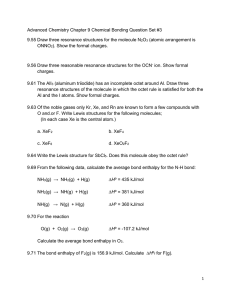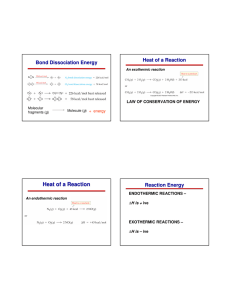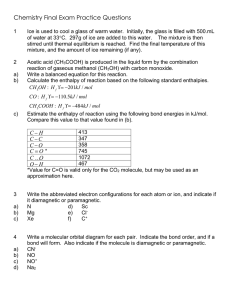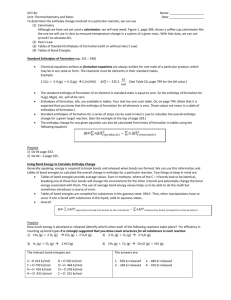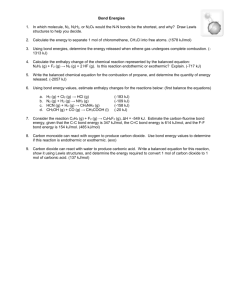Relationship between enthalpy of combustion and number of carbons in
advertisement
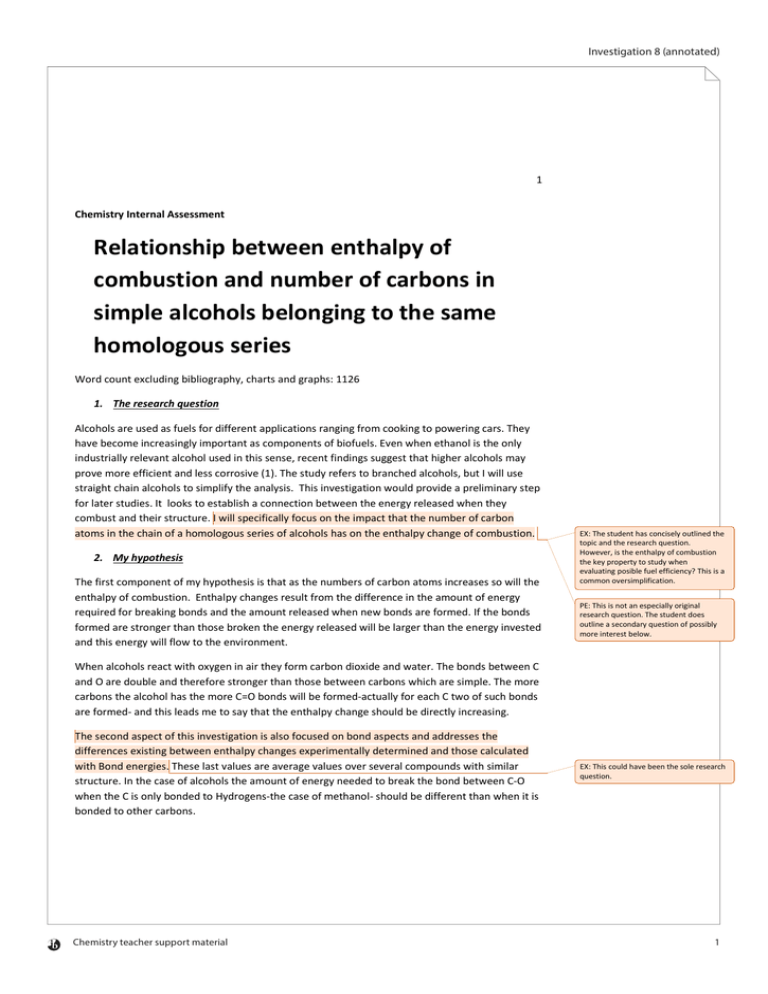
Investigation 8 (annotated) 1 Chemistry Internal Assessment Relationship between enthalpy of combustion and number of carbons in simple alcohols belonging to the same homologous series Word count excluding bibliography, charts and graphs: 1126 1. The research question Alcohols are used as fuels for different applications ranging from cooking to powering cars. They have become increasingly important as components of biofuels. Even when ethanol is the only industrially relevant alcohol used in this sense, recent findings suggest that higher alcohols may prove more efficient and less corrosive (1). The study refers to branched alcohols, but I will use straight chain alcohols to simplify the analysis. This investigation would provide a preliminary step for later studies. It looks to establish a connection between the energy released when they combust and their structure. I will specifically focus on the impact that the number of carbon atoms in the chain of a homologous series of alcohols has on the enthalpy change of combustion. 2. My hypothesis The first component of my hypothesis is that as the numbers of carbon atoms increases so will the enthalpy of combustion. Enthalpy changes result from the difference in the amount of energy required for breaking bonds and the amount released when new bonds are formed. If the bonds formed are stronger than those broken the energy released will be larger than the energy invested and this energy will flow to the environment. EX: The student has concisely outlined the topic and the research question. However, is the enthalpy of combustion the key property to study when evaluating posible fuel efficiency? This is a common oversimplification. PE: This is not an especially original research question. The student does outline a secondary question of possibly more interest below. When alcohols react with oxygen in air they form carbon dioxide and water. The bonds between C and O are double and therefore stronger than those between carbons which are simple. The more carbons the alcohol has the more C=O bonds will be formed-actually for each C two of such bonds are formed- and this leads me to say that the enthalpy change should be directly increasing. The second aspect of this investigation is also focused on bond aspects and addresses the differences existing between enthalpy changes experimentally determined and those calculated with Bond energies. These last values are average values over several compounds with similar structure. In the case of alcohols the amount of energy needed to break the bond between C-O when the C is only bonded to Hydrogens-the case of methanol- should be different than when it is bonded to other carbons. Chemistry teacher support material EX: This could have been the sole research question. 1 Investigation 8 (annotated) 2 The second component of my hypothesis is that the value will be much lower in the case of methanol as the methyl group has a larger inductive effect than other alkyl groups (2). I also think that the difference between the others will be minimal because the C bonded with the O will be bonded to one more C whose electronegativity is the same-therefore no inductive effect- and just two H providing some inductive effect. 3. Finding the enthalpy changes using bond energies In order to validate my hypothesis I will be using values of bond energies obtained from a database instead of practicing the actual experiment. The school only has three alcohols and one of them is branched, therefore it would not be possible to establish a trend. For this purpose I will use the RSC data bank and spreadsheets. The following are the balanced chemical equations: CH3OH(l) + 1. 5 O2 (g) → CO2 (g) +2 H2O (l) C2H5 OH (l) + 3 O2 (g) → 2 CO2 (g) + 3 H2O (l) C3H7OH (l) + 4.5 O2 (g) → 3 CO2 (g) + 4 H2O (l) C4H9OH (l) + 6 O2 (g) → 4 CO2 (g) + 5 H2O (l) Chemistry teacher support material 2 Investigation 8 (annotated) 3 Table 1. Spreadsheet used for calculating Enthalpy changes of combustion based on BE* Met hanol Bond energy (k J/ mol) Overall energy (kJ/mol) Overall energy (kJ/mol) ChangeHcombustion (kJ/mol) H- O 464 464 1856 average C- C 347 0 0 average C- H 413 1239 0 average C- O 358 358 0 C=O in CO2 805 0 1610 4 9 8 .3 748 0 2809 3466 O=O C: The column headings titled “Overall Energy” are ambiguous. Should specify bonds in reactants and bonds in products. C: Final enthalpies cited to more significant figures than the bond energy input data. bonds brok en and f ormed(k j/mol) Et hanol -657 Bond energy (k J/ mol) Overall energy(kJ/mol) Overall energy (kJ/mol) ChangeHcombustion (kJ/mol) H- O 464 464 2784 average C- C 347 347 0 average C- H 413 2065 0 average C- O 358 358 0 C=O in CO2 805 0 3220 O=O 498 1494 0 4728 6004 bonds brok en and f ormed(k j/mol) Propan- 1 - ol -1276 Bond energy (k J/ mol) Overall energy(kJ/mol) Overall energy (kJ/mol) ChangeHcombustion (kJ/mol) H- O 464 464 3712 average C- C 347 694 0 average C- H 413 2891 0 average C- O 358 358 0 C=O in CO2 805 0 4830 O=O 498 2241 0 6648 8542 bonds brok en and f ormed(k j/mol) But an- 1 - ol -1894 Bond energy (k J/ mol) Overall energy (kJ/mol) Overall energy (kJ/mol) ChangeHcombustion (kJ/mol) H- O 464 464 4640 average C- C 347 1041 0 average C- H 413 3717 0 average C- O 358 358 0 C=O in CO2 805 0 6440 O=O 498 2988 0 8568 11080 bonds brok en and f ormed(k j/mol) Pent an- 1 - ol -2512 Bond energy (k J/ mol) Overall energy(kJ/mol) Overall energy (kJ/mol) ChangeHcombustion (kJ/mol) H- O 464 464 5568 average C- C 347 1388 0 average C- H 413 4543 0 average C- O 358 358 0 C=O in CO2 805 0 8050 O=O 498 3735 0 10488 13618 bonds brok en and f ormed(k j/mol) -3130 *The bond energies (BE) were obtained from the RSC database and exported to a spreadsheet to make the calculations (3) Chemistry teacher support material 3 Investigation 8 (annotated) 4 4. Comparing experimental theoretical values with those calculated using bond energies The bond energies are average values obtained from several similar compounds. As a difference to the theoretical experimental values , they do not specifically consider variations resulting from changes in the chemical environment surrounding specific bonds. Table 2. Comparing theoretical experimental values with values calculated using BE Alcohol Exp values (kJ/mol) Methanol -726 Ethanol -1300 Propa-1-ol -2020 Butan-1-ol -2670* Pentan-1-ol -3329** *Reference (4) **Reference (5) Using BE (kJ/mol) -667 -1276 -1894 -2512 -3130 % Difference 8.85 1.88 6.65 6.29 6.36 Graph 1. Heat of combustion released per mol in terms of number of Catoms in the chain Using BE (kJ/mol) A: The two graphs could have been merged into one for better comparative effect. ΔH of combustion (kJ mol -1) 3500 3000 2500 2000 1500 1000 500 0 0 2 4 Number of C atoms in the chain 6 Graph 2. Heat of combustion released per mol in terms of number of Catoms in the chain Chemistry teacher support material 4 Investigation 8 (annotated) 5 Heat of combustion released per mol Using exp theoretical values (kJ/mol) 4500 4000 3500 3000 2500 2000 1500 1000 500 0 0 1 2 3 4 5 6 7 Number of Catoms in the chain 5. Analysis Both the theoretical experimental results and those resulting from calculations based on BE showing a positive linear relationship which validates my hypothesis. All the values resulting from using bond energies (BE) are lower than the experimental ones found in references. It is worth mentioning that the RSC Database provides the H-O value corresponding to water which should be different from that in a hydroxyl as the chemical widely varies. It is interesting that the experimental value of ethanol -while still on the line- appears as lower than the other experimental values. This is not observed in the values based on BE where the five energy values are perfectly aligned. Ethanol´s value is clearly lower than that of methanol and slightly lower than the other higher alcohols. Therefore there seems to be some structural difference between ethanol and the rest, with a more marked variation with the first member of the homologous series. I tend to believe that this may result from the significantly lower inductive effect that the ethyl group has on the C-O bond when compared with the methyl group. If the inductive effect is lower the bond is less polar, resulting in an increased covalent character and therefore a stronger bond. As the bond is stronger more energy is needed to break it, and the enthalpy change would therefore be smaller. The inductive effect is not changed by adding CH2 in the higher alcohols but still there must be some, as they are slightly lower than methanol (but perfectly aligned with each other). Still other possibility is that differences result from experimental errors which references do not report. Results may suggest that the difference in the bond O-H could be affecting alcohols to a different degree. More data are needed to clarify why the second CH2 affects the C-O bond in ethanol but not in the rest providing a satisfactory explanation for this anomaly. Chemistry teacher support material EV: Trying to explain findings in terms of relevant theory which is good. 5 Investigation 8 (annotated) 6 Values established for BE correspond to gaseous states of the reactants and products. The experimental values though address liquid states for the alcohols and water. Thus, the previous analysis is limited as it has not taken into account the heat of condensation. EV: Valid consideration. 6. Final reflections I may finally conclude that my hypothesis has been validated both by experimental values found in cited resources and those calculated using bond energies. The investigation has evidenced that there is a positive linear relationship between the ΔH of combustion and the number of C atoms in a homologous series of simple alcohols. It has also shown that results based on bond energies are lower than those experimentally obtained underlining the relevance of chemical environments in the energy needed to break specific bonds even when extremely similar. An unexpected small anomaly was found in the experimental value of ethanol which is not shown in the trend based on bond energies, reinforcing the limitations that average values may impose on accurate descriptions. 7. Bibliography (1) http://www.nature.com/nature/journal/v451/n7174/abs/nature06450.html Accessed February 2012 (2) http://www.transtutors.com/chemistry-homework-help/general-organicchemistry/inductive-effect.aspx Accessed February 2012 (3) http://www.rsc.org/education/teachers/resources/databook/ Accessed February 2012 (4) http://en.wikipedia.org/wiki/Heat_of_combustion Accessed February 2012 (5) http://en.wikipedia.org/wiki/N-Butanol Accessed February 2012 (6) http://www.docbrown.info/page07/delta1Hd.htm Accessed February 2012 Chemistry teacher support material 6
